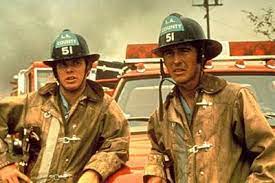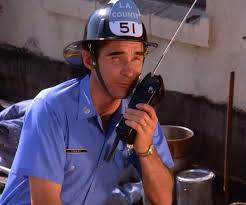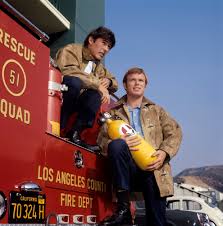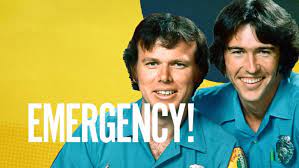“Emergency!” was a popular television show that aired from 1972 to 1979. The show focused on the daily lives of paramedics and firefighters who worked for the Los Angeles County Fire Department. It was created by Robert A. Cinader and Jack Webb, who was also the creator of the hit shows “Dragnet” and “Adam-12.”
[Note: To keep this article a bit more readable, we will use “Emergency” without the famous exclamation point when citing the show name.]
The show was praised for its realism and accuracy in portraying the work of emergency responders. The characters and storylines were based on real-life incidents and the show featured technical advisors from the fire department to ensure accuracy. The show was also notable for its use of the latest technology and equipment, such as the use of the then-newly introduced paramedic program.
Despite being a fictional show, “Emergency” significantly impacted the public’s perception of emergency responders and their work. The show helped to raise awareness of the importance of emergency medical services and the need for well-trained personnel. It also inspired many viewers to pursue careers in emergency services. Today, the show remains a beloved classic and a testament to the bravery and dedication of those who work in emergency services.

Overview of Emergency
Plot
The show’s main characters are paramedics John Gage and Roy DeSoto, played by Randolph Mantooth and Kevin Tighe, respectively. The two paramedics respond to various emergency calls throughout the city, ranging from medical emergencies to natural disasters. They are often accompanied by the firefighters of Station 51, including Captain Stanley, played by Michael Norell, and firefighter Chet Kelly, played by Tim Donnelly.
The show is known for its realistic portrayal of emergency services and medical procedures. The show’s creators worked closely with the Los Angeles County Fire Department to ensure accuracy in the show’s depiction of emergency services. In fact, the producers pulled the show’s plotlines directly from first responder reporters to ensure a genuine portrayal.
Throughout the show’s run, Emergency tackled various social issues, including drug addiction, racism, and the Vietnam War. The show was praised for its ability to address these issues in a sensitive and thoughtful manner while still maintaining its focus on emergency services.
STAFF MEMORY: Despite having seen the episode 40+ years ago, one of our staffers remembers the storyline of episode 57 (“Gossip”), in which the team comes to the aid of a child who was suffering from cyanide poisoning after eating a peach pit. The staffer reports she never forgot that and studiously avoided peach puts forever thereafter.
Characters
Main Characters in Emergency
“Emergency” centers around the lives of two Los Angeles County Fire Department paramedics, John Gage and Roy DeSoto. John is portrayed as a ladies’ man, while Roy is the more serious of the two. Both characters are well-developed and have their own unique personalities.
The show also features Dr. Kelly Brackett, a skilled and dedicated physician at Rampart General Hospital. Dr. Brackett is often seen working alongside the paramedics, providing medical expertise and guidance in emergency situations.
Supporting Characters
Other notable characters in “Emergency” include Captain Stanley, the head of Station 51, and his assistant, Chet Kelly. Captain Stanley is a strong leader respected by his team, while Chet is often portrayed as the class clown, always looking for ways to lighten the mood.
The show also features a number of recurring characters, including Nurse Dixie McCall, who works alongside Dr. Brackett at Rampart General Hospital, and Firefighter Mike Stoker, who is known for his mechanical expertise and often helps the team with their vehicles.

Production of Emergency
Development and Creation
The idea for Emergency was inspired by a series of articles in the Los Angeles Times about the newly created paramedic program in the city. The articles highlighted the heroic work of the paramedics and firefighters who were saving lives on a daily basis. Webb saw the potential for a new show that would showcase the bravery and dedication of these first responders.
Webb worked closely with Robert A. Cinader, a former firefighter and the show’s executive producer, to develop the concept and characters for Emergency. They consulted with real-life paramedics and firefighters to ensure the show was as authentic as possible.
Filming and Locations
The show was filmed on location in Los Angeles, using actual fire stations and hospitals as sets. The firefighters and paramedics who appeared on the show were often real-life first responders who worked in the city.
The show was known for using authentic equipment and vehicles, including the iconic red and white fire engine and squad truck. The crew also used a variety of cameras and filming techniques to capture the action and drama of the emergency situations depicted on the show.

Emergency was a groundbreaking show that helped to popularize the concept of paramedics and emergency medical services in the United States. Its realistic portrayal of this profession’s challenges and rewards helped inspire a new generation of first responders.
FUN FACT: The show’s classic Fire Engine 51 (both of them!) is now proudly displayed at the Los Angeles County Fire Museum.
Emergency: A Proud Legacy
The impact of Emergency on television and its cultural significance cannot be overstated. The show pioneered the medical drama genre and paved the way for many other shows that followed in its footsteps.
Impact on Television
Emergency was the first show to feature paramedics as main characters, a groundbreaking concept at the time. The show’s realistic portrayal of emergency medical services inspired many people to pursue careers in the field. In addition, Emergency was one of the first shows to use real-life medical procedures and terminology, which added to its authenticity and credibility.
Emergency also had a significant impact on the way television shows were produced. The show’s use of handheld cameras and on-location shooting techniques gave it a realistic, documentary-style feel that was ahead of its time. This influenced many other shows to adopt similar techniques.
Cultural Significance
Emergency was not just a popular television show. It was a cultural phenomenon. The show’s portrayal of paramedics and firefighters as heroes who risked their lives to save others was inspiring to many people. It also helped to raise awareness about the importance of emergency medical services and the need for better funding and resources.
Emergency had a lasting impact on popular culture as well. The show’s theme song, written by Nelson Riddle, became a hit single and is still recognized today as an iconic piece of television music. The show also spawned a number of spin-offs and imitators, which is a testament to its enduring popularity and influence.

